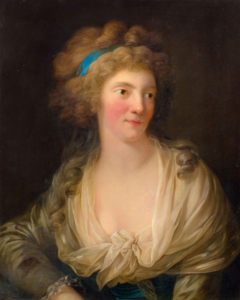The Piano Sonata No. 18 in D major, K. 576, was composed by Wolfgang Amadeus Mozart as part of a set of six for Princess Frederica Charlotte of Prussia in 1789.[1] It is often nicknamed "The Hunt" or "The Trumpet Sonata", for the hornlike opening.[2] The sonata, having a typical performance duration of about 15 minutes, is Mozart's last. It was the only one of the intended set of six.
| Piano Sonata in D major | |
|---|---|
| No. 18 | |
| by W. A. Mozart | |
 | |
| Other name | The Hunt The Trumpet Sonata |
| Key | D major |
| Catalogue | K. 576 |
| Style | Classical period |
| Composed | 1789 |
| Dedication | Princess Frederica Charlotte of Prussia |
| Published | 1805 |
| Movements | Allegro, Adagio, Allegretto |
Date of the sonata edit
In a letter to a fellow Freemason Michael von Puchberg, dated 12 July 1789, Mozart wrote "meanwhile I am working on six easy piano sonatas for Princess Friederike and six quartets for the King". Hermann Abert believed K. 576 to be one of these sonatas; however, Wolfgang Plath and Wolfgang Rehm stated in the Neue Mozart-Ausgabe that they doubted this, as K. 576 is demanding to play, often considered one of Mozart's hardest sonatas, due to its technically difficult counterpoint passages. Charles Rosen offered a moderate viewpoint, considering that Mozart may have mistakenly believed that these passages were easy (as they are in two parts, one in each hand), even if they are not actually so in practice. The work was published posthumously in 1805.
Movements edit
As was typical of the time, the work is in three movements, in a standard fast, slow, fast order:
I. Allegro edit
In D major, the first movement is in sonata form and begins with both hands in unison, followed by some trills and a repeat in E minor. This material is used and varied for the first theme, finally cadencing to the dominant, where the second theme provides a more graceful contrast to the grandness of the first. The development section includes many different keys, but starts in the dominant, using counterpoint and harmonic imbalance and exploration. This gives a feeling of tension, which is then resolved before returning to the recapitulation in the home key.[3] Tension and release was a key aspect of the classical era, as it provided composers with a chance to interrupt cadences and draw out tension in order to create an exciting piece. It also helped to extend melodies as a new theme could be made after the release, as is shown in this movement.[4]
II. Adagio edit
The middle movement is in the dominant key of A major and includes many scale passages as well as counterpoint. Mozart uses harmonic exploration throughout the sonata such as suspensions and dissonances. There are some chromatic elements in this movement, as is common in many of Mozart's later works. Diminished chords are used to help modulate frequently and a series of keys are cadenced into. These harmonies can also allow more melodic techniques to be used.[1]
III. Allegretto edit
The last movement has a playful mood and is light in texture, however the articulation is marked carefully and precisely to maintain clarity, as was common of the time. It is in sonata rondo form. The first theme is followed by a number of scale passages and a short series of arpeggios. The same material is used for the rest of the piece, although there are some differences towards the end.[6]
References edit
- ^ a b Wigmore, Richard. "Piano Sonata in D major, K576". Hyperion Records. Retrieved 24 June 2023.
- ^ Hiroshima, Grant. "Sonata in D, K. 576". Los Angeles Philharmonic. Archived from the original on 31 January 2018. Retrieved 20 February 2016.
- ^ Piano Sonata No. 18 in D major ("Trumpet", "Hunt"), K. 576 at AllMusic
- ^ Saindon, Ed (1 May 2014). "Tension and Resolution". Berklee College of Music. Retrieved 25 June 2023.
- ^ Benward, Bruce; Saker, Marilyn (2009). Music in Theory and Practice. Vol. II (8th ed.). McGraw Hill. p. 75. ISBN 978-0-07-310188-0..
- ^ "Wolfgang Amadeus Mozart: Sonata in D major, K. 576" (PDF). Seattle Symphony. Retrieved 20 February 2016.
External links edit
- Sonate in D KV 576: Score and critical report (in German) in the Neue Mozart-Ausgabe
- Piano sonata in D major, K. 576 (interactive score) on Verovio Humdrum Viewer (Alte Mozart-Ausgabe version)
- Piano Sonata No. 18 in D major, K. 576: Scores at the International Music Score Library Project